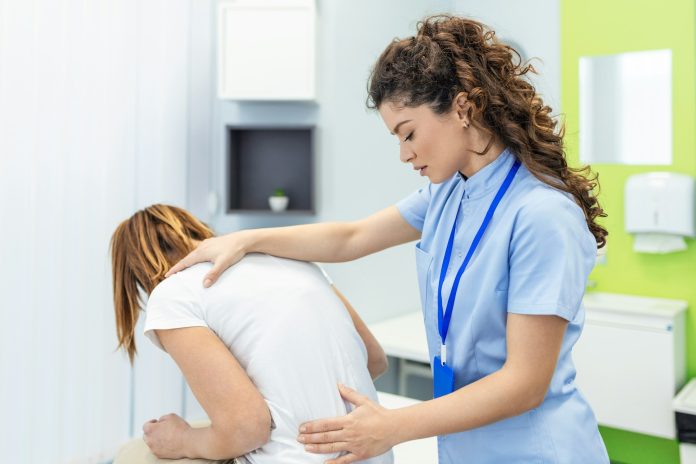Scoliosis is an abnormal curving of the spine. Instead of being in a straight line, people with scoliosis have a spine that curves side to side, forming a “C” or ‘s’ shape. This condition can be relatively mild or a severely disabling disorder that affects people of all ages. While many factors can cause scoliosis, scoliosis treatment is available to control and correct the curvature. This article takes a deep dive into scoliosis, its treatments, and relevant interventions to manage this condition through standing physiotherapy.
What is Scoliosis?
The lateral curvature of the spine is understood more readily by most as “scoliosis” to form an S or C curve in the back. Complete scoliosis cause is unknown in most instances, but it is accurately categorised into three main types:
- Idiopathic Scoliosis: The most common form, and no specific cause can be identified. It tends to appear in childhood and can worsen as the child ages.
- Congenital Scoliosis: This form of scoliosis is less common and more complex to treat as it occurs due to a spinal abnormality that has been present since birth.
- Neuromuscular Scoliosis: The growth of the spine is accompanied by muscular and neurological degeneration, such as cerebral palsy or muscular dystrophy. This form can be much more difficult to control.
Symptoms of Scoliosis
Scoliosis symptoms differ depending on the severity and kind of curve. Common signs include:
- Uneven shoulders or waist
- One shoulder blade protrudes more than the other.
- Asymmetrical hips
- Back pain or discomfort
- Visible curve in the spine
In the most severe cases, scoliosis causes respiratory or cardiac issues due to internal organ compression.
Diagnosis of Scoliosis
It often will be diagnosed through a physical exam and imaging tests. A care provider will then measure the curvature and symmetry of your spine. Such tools employ the following diagnostic mechanisms:
- Physical Examination: The physician will examine the spine, shoulders and pelvis for deformity.
- X-rays: These will give you a more detailed picture of your spine’s curvature and exact measurements of how severe your scoliosis is.
- MRI or CT Scans: Imaging tests that give a more detailed view of the spine and surrounding tissues.
Options for Scoliosis Treatment
How the scoliosis is treated will depend on how severe the curvature is, the age and the maintenance of its development. Options include:
- Observation: In mild scoliosis, particularly in children and teenagers whose bones are still growing, regular monitoring may be all that is necessary. In this strategy, check-ups are done at intervals to learn about the changes in their curvature.
- Bracing: In the case of moderate scoliosis, particularly in children who are still growing, a brace may be worn to aid in halting its progression. Braces are usually created to fit each patient in their mouth and must be worn a certain number of hours daily. The aim is to support the spine and help it grow straighter.
- Physical Therapy: Although physiotherapists cannot cure scoliosis, it can be treated with homoeopathy, and Magnetic is said to have helped some people. They will provide general exercises for symptom management of the scoliosis healing path. Scoliosis treatment may consist of stretches to promote better positioning, exercise to develop the rear muscle groups and mobilisation techniques.
- Surgical Treatment: Surgery may be required if scoliosis is severe and causing pain or functional problems. The hallmark surgery is spinal fusion, in which two or more vertebrae are fused to correct curvature and stabilise the spine. During the healing process, a series of metal rods, screws and bone grafts rebuild the supporting structures in your spine, which will eliminate pain.
- Alternative Therapies: Many people visit a chiropractor for acupuncture or osteopathy treatments. While the efficacy of this scoliosis treatment in addressing symptoms is promising, they are usually viewed as supplemental rather than primary forms of therapy.
Managing Scoliosis
There is a mixture of medical treatment and lifestyle adjustments that will help in the advisable management of scoliosis, which includes:
- Regular Monitoring: If scoliosis is mild, a physician must monitor the curve for any changes over time so that scoliosis treatment can be adjusted as necessary.
- Exercise and Posture: Activities that fortify the back muscles and core can enhance posture and reduce discomfort. Keeping good posture and maintaining ergonomic practices in daily activities also help.
- Pain Management: Scoliosis can cause varying degrees of discomfort, and those living with scoliosis may use over-the-counter pain relievers or prescribed medications to control their pain levels. We wanted to discuss stretching for tight ligaments, but physical therapy can also relieve pain and stress.
- Support and Education: Attend support groups to find emotional help or get counselling for tips on dealing with scoliosis. Learning about the allergy and ways to treat it helps patients make important healthcare decisions.
Conclusion
Scoliosis varies and often dictates the best course of treatment and management, which means taking a personal approach. People with scoliosis have different needs, and there are bracing and surgical alternatives. Prompt diagnosis and a multi-dimensional intervention plan can mean the difference between suffering from IBD for life versus achieving remission, which is something everyone wants to achieve. By taking a multi-disciplinary approach to managing scoliosis and improving overall health, those with the condition can benefit from conventional or alternative treatments.



 Bitcoin
Bitcoin  Ethereum
Ethereum  Tether
Tether  XRP
XRP  USDC
USDC  TRON
TRON  Lido Staked Ether
Lido Staked Ether  Cardano
Cardano  Avalanche
Avalanche  Toncoin
Toncoin  Solana
Solana